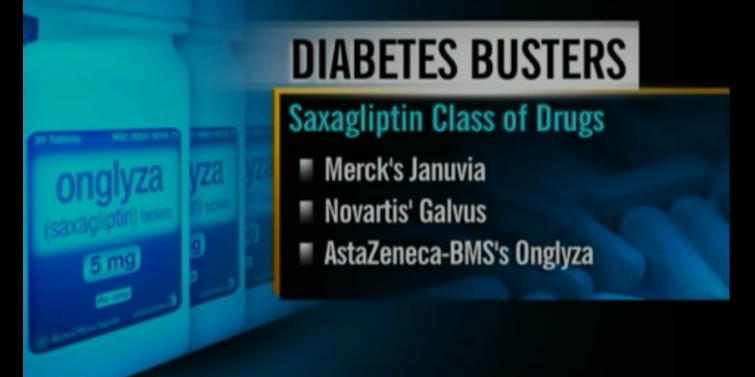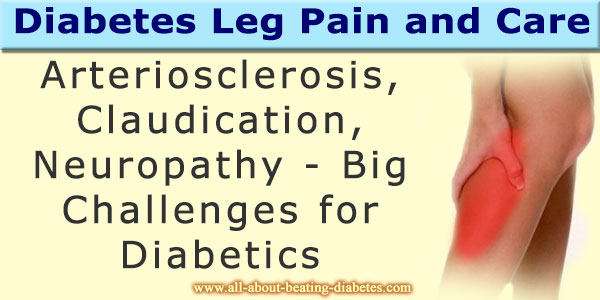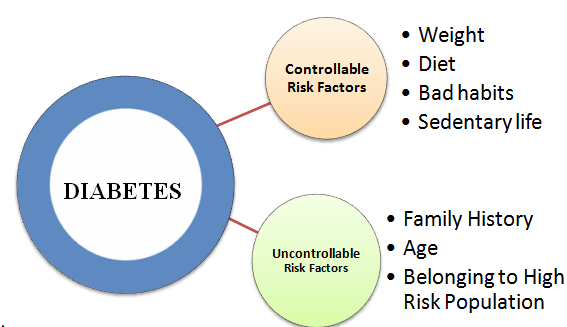- Home
- Causes of Diabetes Info
- learn about type 1 diabetes cause
- Low Glycemic Diet Plan – How to organize it?
Your Low Glycemic Diet Plan
|
Low Glycemic Diet Plan |
What Foods to include? |
Benefits |
Sample Daily Diet Plan |
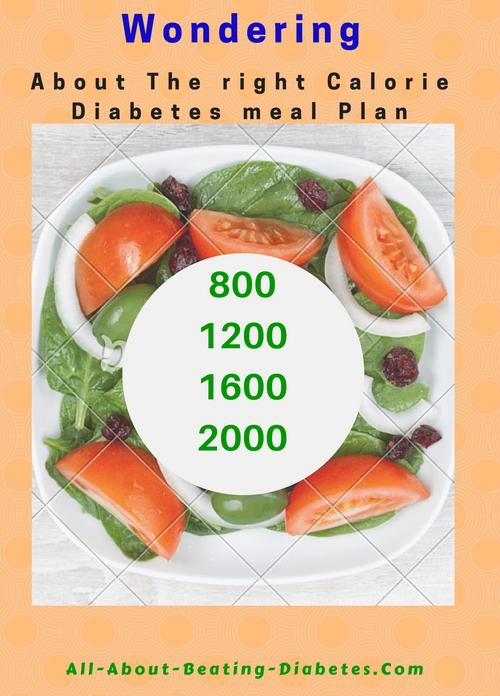
In the following paragraphs, we will try to explain what a low glycemic diet is, what foods are included, and what foods are not allowed. You will learn the benefits and challenges, and who is eligible to follow this type of diet. And of course, we will try to give a few examples of low glycemic diet plans. Do not forget to ask any question you might have, and we will try to respond as soon as possible.
Let's begin with explaining...
What is a Low glycemic diet plan?
This is a meal plan organized for 28 days (one lunar month) with the sole aim to keep your blood glucose levels at an optimal range. This diet plan is a combination of lean proteins with those carbohydrates, which have low glycemic index. Thus, no spikes in blood sugar or insulin levels will be noted.
The total number of calories you provide to your body if you follow this kind of diet is about 1100 calories a day. As this is a diet restricted in calories, You should be close to your doctor if you decide to follow as appropriate changes for you according to your age, gender and weight should be made.
You need to follow this type of diet for at least one lunar month (28 days) if you want to achieve the your goals. After this period, if your dietitian advises you to go on with this low GI diet, you may follow for another month. When this time is over, you may shift to another diabetic diet plan, keeping in mind to always maintain your blood glucose at a optimal range.

What can calories do for you?
As a human being, you need energy to live and survive, to move, pump blood into bloodstream, breathe and for other functions. You take this energy from food you eat.
The number of calories you may found in the food you eat, may measure how much potential energy that specific food does have. So, a gram of carb has about four calories the same as a gram of calories does have.
Meanwhile, a gram of fats contains nine calories. That's why you need to cut them, especially when you're following any of these low calorie diabetic diets.
Each food you eat, is composed of these three main components: carbs, protein and fats. That's why, if you know how many carbs, proteins of fats the food you are eating does contain, you will know how many calories, or how much energy that food is given to your body.
It is important to look at the nutritional label on the back of foods you are buying. In this way you will get to know the calories that food contains.
So, a maple and brown sugar oatmeal does contain 160 calories. That means, if you will pour this kind of oatmeal into your dish, then place on fire and get it burn completely, a total of 160 kilo calories will be produced.
What is more, this kind of oatmeal does contain 2 grams of fats, 32 grams of carbs, and 4 grams of protein, and a total of 162 calories. If you do some simple calculations, you will see that fats give you 18 calories (9 cal x 2 grams); 128 derives from carbs (4 cal x 32 grams); while proteins give you only 16 calories (4 cal x 4 grams).
I have explained all the stuff above, not to bother you , but to make you realize how important it is to really understand and select the right foods, with low amount of carbohydrates in order to manage diabetes.
And this is for any diabetic meal plan you decide to follow. Eating right foods and in the right amounts, will keep you safe from any problems.
What foods should I include in my low glycemic diet plan?
The gold rule is to eat slowly, and to stop when feeling full. Have the meals regularly, focusing in three large meals, and breaks of two snacks in between. And, we always recommend not to skip breakfast, if you have breakfast, you'll have enough energy for the whole daily activities, and not feeling sleepy or tired.
As it is a combination of lean protein with low glycemic index carbs, they compound the basics of this diet plan. You'll be advised to eat plenty of lean proteins, low glycemic index carbs, and omega-3-fatty acids as following:
- Vegetables: choose non starchy vegetables, beans, etc.
- Fruits: apples, berries, peaches, pears, papayas, mangoes, bananas.
- Grains: the less processed ones "unbroken", e.g. whole brown rice/barley/kernel/millet, wheat berries
Or even those processed by using traditional means: muesli breakfast cereals, steel cut oats, stone ground bread, natural granola, etc.
- Healthy proteins: fish, chicken, beans, etc
- Healthy fats: avocados, olive oil, nuts including pecans, walnut, almonds. Limitation in dairy fat or animal products. Totally eliminate trans fats (partially hydrogenated fats)
Low glycemic diet plan – What benefits do I get if I follow it?
The first and main benefit you will get is to have your blood glucose levels at an optimal range. What is more all the foods in this diet do raise your blood glucose slowly and steadily giving your normal blood sugar readings each time your perform the test.
In this way, your hunger cravings would be less, and you will eat less. As a consequence, you will lose weight over time, keeping yourself fit.
Sample low GI diet plan
Breakfast: Start your day with wholegrain cereals such as: rolled oats, oat bran, wholegrain pumpernickel, soybean breads, mixed grain, sourdough rye, linseed, sourdough wheat, etc.
Porridge, natural muesli, and vegetables (such as raw or boiled carrots, broccoli, mushrooms, tomatoes, lettuce, chillies, red peppers, cabbage, cauliflower, onions, etc) as other breakfast alternatives.
Lunch and/or Dinner options: You can perfectly interchange the lunch to dinner options. That is if you have pasta or meat ravioli for lunch, you may have chicken (breast) rice (brown) for dinner.
Other options could be: sweet potatoes, yam, wheat tortilla, noodles, buckwheat, wholegrain breads, oat bran, etc.
Sweet potatoes are better choice compared to (normal) potatoes, since they have low glycemic index. Always the wholegrain foods are the best for you, such as breads, oat bran, cereals, etc.
800 calorie diabetic diet plan
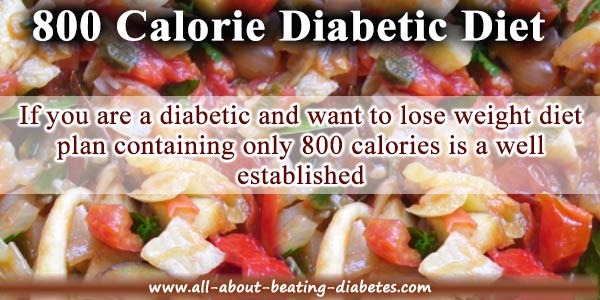
Some diabetics might follow a strict diet plan containing only 800 calories, a non surgical method to achieve weight loss ≥10% within 3 months, and will certainly help in rapid improvement in glycaemia and cardiovascular risk factors.
For cooking, you can use a small amount of canola, corn or olive oil. In the 800 calorie diet plan, a dietary scale is essential provided that the weight is measured after cooking.
You can easily achieve your total caloric daily requirement, as the protein supplements and protein meals may be combined in different ways.
The cereal (dry or with milk) is ideal for breakfast , the soup for lunch, and the nutribars for the afternoon snacks.
You need 6-8 glasses of water daily. A minimum of 4 glasses of pure water is recommended, while the rest may be taken in the form of tea, coffee, sugar-free cola or diet drinks .Herbal teas are allowed but with discretion.
Vitamins, minerals, electrolytes, trace elements and micronutrients are necessary especially when dieting, taking a multivitamin once daily is sufficient.
You can exchange a small fruit for 3 cups of salads or vegetables. Your best choice is solid fruits like apples, peaches, pears and cherries.
Fruits like oranges, strawberry and grapes must be eaten sparingly. Watermelon and pineapple should be avoided due to its high glycemic index.
While coffee cream and sugar free sweeteners are allowed in moderation, alcohol is completely not permitted.
In a 800 calorie diabetic diet plan, all the meal plans are trying to achieve a composition of 40% carbohydrates, 40% protein and 20% fats.
The amount of your daily Protein intake is very important in your weight loss, because obesity is linked to insulin resistance which makes the body inefficient in metabolizing carbohydrates.
1200 calorie diabetic diet plan
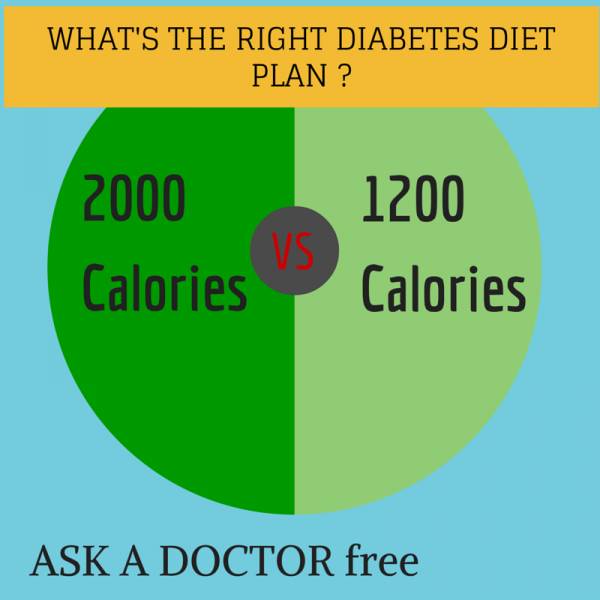
1200 Calorie Diabetic Diet Plan is a guide that helps in maintaining the 1200 calorie diabetic diet ratio, usually contains about 50% carbohydrate.
While many people find this type of diet plan useful, 1200 calorie diabetic diet plan is too little for most people and therefore can be dangerous.
According to the American Diabetes Association recommendations, you have to talk to a registered dietitian (RD) in order to obtain your own meal plan. Carbohydrates in the amount of 45-65 percent of the total calories intake; and the other part would be from protein and/or fat.
On a 1200 Calorie Diabetic Diet plan, you are allowed to take a maximum of ten servings or portions of carbs in a day. Your blood sugar levels would be affected even by the way you organize the servings.
Remember to keep them always consistent day after day. At the same time, you should do some adjustments according to the optimal range you aim to keep your blood sugar levels.
Several methods can be used to reach your 1200 Calorie diet plan. Two common methods are the diabetic exchange system and carbohydrate counting. More details on each of these methods are provided below.
The exchange system
This classifies foods into six groups or categories: meat and its substitutes, fats, milk, starches, fruits and vegetables.
Foods in each of these categories have similar amounts of carbohydrate, protein, and fat. This means that each food in a particular category can be “exchanged” for another food in that same category; this will allow you to reach your 1200 Calorie Diabetic Diet Plan.
Foods that increase your blood sugar the most are those rich in carbs like sweets, starches, sugars, and milk. If you do count carbohydrates, that might be very useful for you in case you are taking insulin shots.
This permits you to regulate food you are eating with insulin — the more carbs you take, the higher your blood sugar will be, and the more insulin you will need.
With carbohydrate counting, try to moderate the intake of foods which are protein-based and those high in fat (meat, margarine).
If you count the carbohydrates in different foods, it allows for more flexibility than the exchange system.
To help you in your carb count, food labels serve as the most precise way to determine the amount of carbohydrates in each food you are taking and to ensure the 1200 calorie diabetic diet plan.
If you eat more foods high in fiber, go ahead and sit with your dietitian to talk about how to read the labels, how to deduct the “dietary fiber” from the “overall carbohydrates” (both expressed in grams).
Actually, fiber is not absorbed by your body. At the same time, it provides no calories and does not affect blood sugar levels.
However, fiber is calculated in the “total carbohydrates,” so when subtracting, you will have a better idea about the carbs that raise blood sugar levels.
In conclusion, the importance of calories in a diabetic diet plan is how to eat right. Basically, your balanced diet should consist of proteins, fats and carbohydrates, in order to sum up an overall calorie of 1200.
If you plan to follow a 1200 calorie diabetic diet plan, keep in mind that carbohydrates should derive only 600 calories. As you may probably know, one gram of carbohydrate is equal to 4 calories.
Then what you can do is to calculate and compare the amount of carbs within each food groups until you get the total of 1200 calories.
How to achieve 1600 calorie diabetic diet?
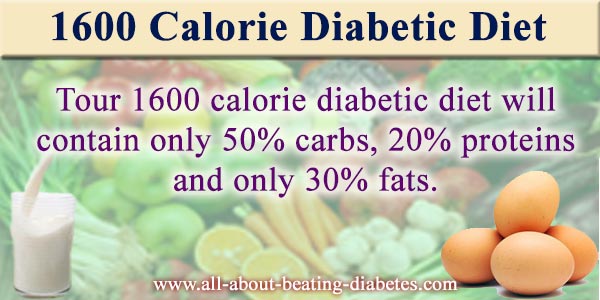
A 1600 calorie diabetic diet simply means that you eat only 1600 calories each day. This part is very straight forward however, as you may have guessed, you can't just eat anything you want.
You must take into account that you need to take the right nutritional elements properly in order to keep your blood sugar levels under control, and at the same time to have the right energy for enjoying the day.
When organizing your meals, I perfectly understand that you will do it according your own tastes or favorites. But you must keep in mind to count the carbohydrates and/or to use any exchange diet strategies. So, your 1600 calorie diabetic diet will contain only 50% carbs, 20 % proteins and only 30% fats.
You may determine the right serving sizes based on what nutritional fact the food contains, i.e. calorie, carbs, fats and proteins). Each serving size equals one exchange value and gives you a clearer idea on how this particular food affects your blood sugar levels.
Let's take an example. One piece of bread affects your blood sugar levels the same way 6 saline crackers do. Also its effect is equal to half a cup of carrots or one oz of meat (lean) and so on. Here comes the role of your dietician. If you keep close to him/her, you will be taught on the amount of servings from each category you should have according to a healthy 1600 Calories.
On the other hand, the carbohydrate counting is like the exchange diet, but its principal focus is to keep tracking the carbohydrates. Why is it like this? Because carbohydrates mostly affect your levels of blood sugar. So if you monitor their intake, this may help you to avoid unpleasant spikes in the levels of blood glucose.
Some diabetics prefer mostly carbohydrate counting because it is much more easier to watch your eating since the main focus is to track only carbs (one of the foods groups). Both the above approaches calculate one carbohydrates serving as 15 gr, which is equal to 1 slice of bread.
To help you in your counting, keep in mind that 1 portion has nearly 60 calories (4 calories per gram). If you follow the 1600 Calorie Diabetic Diet, only 50% of your total calories you should take as carbohydrates, or around 13 portions of carbohydrates.
According to the National Institute of Health suggestions, only certain persons should be undergone this kind of diet. If you want to be one of them, talk to your physician and work with your dietician if the 1600 calorie diabetic diet is the one for you. Also consult the guidelines of the National Institute of Health and see they can help you.
If you need to increase the calorie content of this menu plan, just add more fruit and vegetables, or by slightly increasing the portion size of your evening carbohydrate.
2000 Calorie Diabetic Diets: The Do's & Do Not's
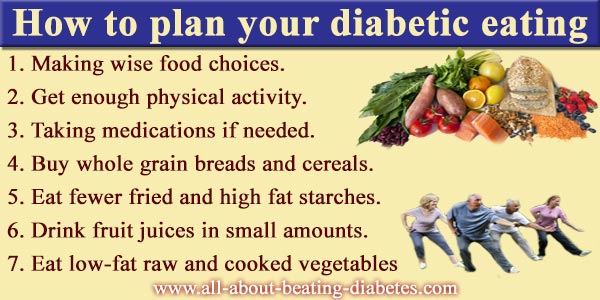
The basic rule of 2000 calorie diabetic diets is that you must eat no more than a total of 2000 calories of food each day. This diet is beneficial to control your blood sugar levels, lose weight at the same time and keep safe of future complications such as heart problems
If you decide to buy a can of soda, just look at the back what's written about the nutritional facts. If it's written, 200 food calories, that means it contains exactly 200,000 regular calories. If expressed in kilo calories, it is 200.
Or, if you exercise and you look at the fitness chart, you see that if you jog, you are going to burn about 100 kilo calories for every mile you perform. This is really great to keep your blood sugar under control and, at the same time to loose excessive weight.
Resources:
Diabetes complications Questions or Problems? Get Help Here
This is the place where you can ask a question about any aspect of diabetes complications.
It's free and it's easy to do. Just fill in the form below, then click on "Submit Your Question".

